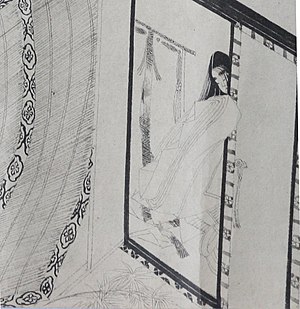The Pillow Book (literature)
 An illustration of a 13th Century scroll of the book, depicting Sei Shonagon | |
| Original Title: | 枕草子 |
|---|---|
| Written by: | Sei Shonagon |
| Central Theme: | The thoughts of Sei Shonagon. |
| Synopsis: | A collection of essays, anecdotes, poems, and descriptive passages that have little connection to one another except for the fact that they are ideas and whims of what Shōnagon was thinking of in any given moment in her daily life. (Wikipedia) |
| Genre(s): | Zuihitsu ("random jottings") |
| First published: | 1002 |
The Pillow Book is one of the masterpieces of Japanese literature. Written during the Heian period by Sei Shonagon, lady-in-waiting of Empress Sadako, it is an impressionistic compendium of hundreds of things classified by categories ("Rare things", "Things that make the heart beat faster", "Things that bring up fond memories of the past", etc.) as well as everyday scenes at the Japanese imperial court at the turn of the 11th century.
Peter Greenaway used the book as a basis for a movie, also titled The Pillow Book, which focuses on Kiyowara Nagiko, a modern-day fan and emulator of Sei Shonagon.
This page needs a better description. You can help this wiki by expanding or clarifying the information given. |
Tropes used in The Pillow Book (literature) include:
- Japanese Politeness: Etiquette at the Heian court was so refined, it would make 18th-century Versailles look sloppy. If you wanted to ask a woman out, you'd better do it in the form of an exquisitely calligraphed poem.
- Not Staying for Breakfast: Sei Shonagon writes disparagingly of lovers who don't have the good sense to sneak out before daybreak.
- Shrines and Temples: The ladies of the court regularly go on pilgrimages to famous Buddhist temples.
- Unlimited Wardrobe: Sei Shonagon makes a point of mentioning her keen sense of fashion, by describing both her own dress (which never seems to be twice the same) and that of other courtiers. Wear yesterday's fashion in her presence and she'll never speak to you again.
- Oh, she will. It's just that she'll also list you as one of the "Things that should not be looked at".
- She loosens up by the end of the book. She loosens up insofar as she says at one point "clogs with trousers may be in fashion right now, but they're still ugly."
- Upper Class Twit: Plenty of those at the Imperial court.
This page needs more trope entries. You can help this wiki by adding more entries or expanding current ones. |